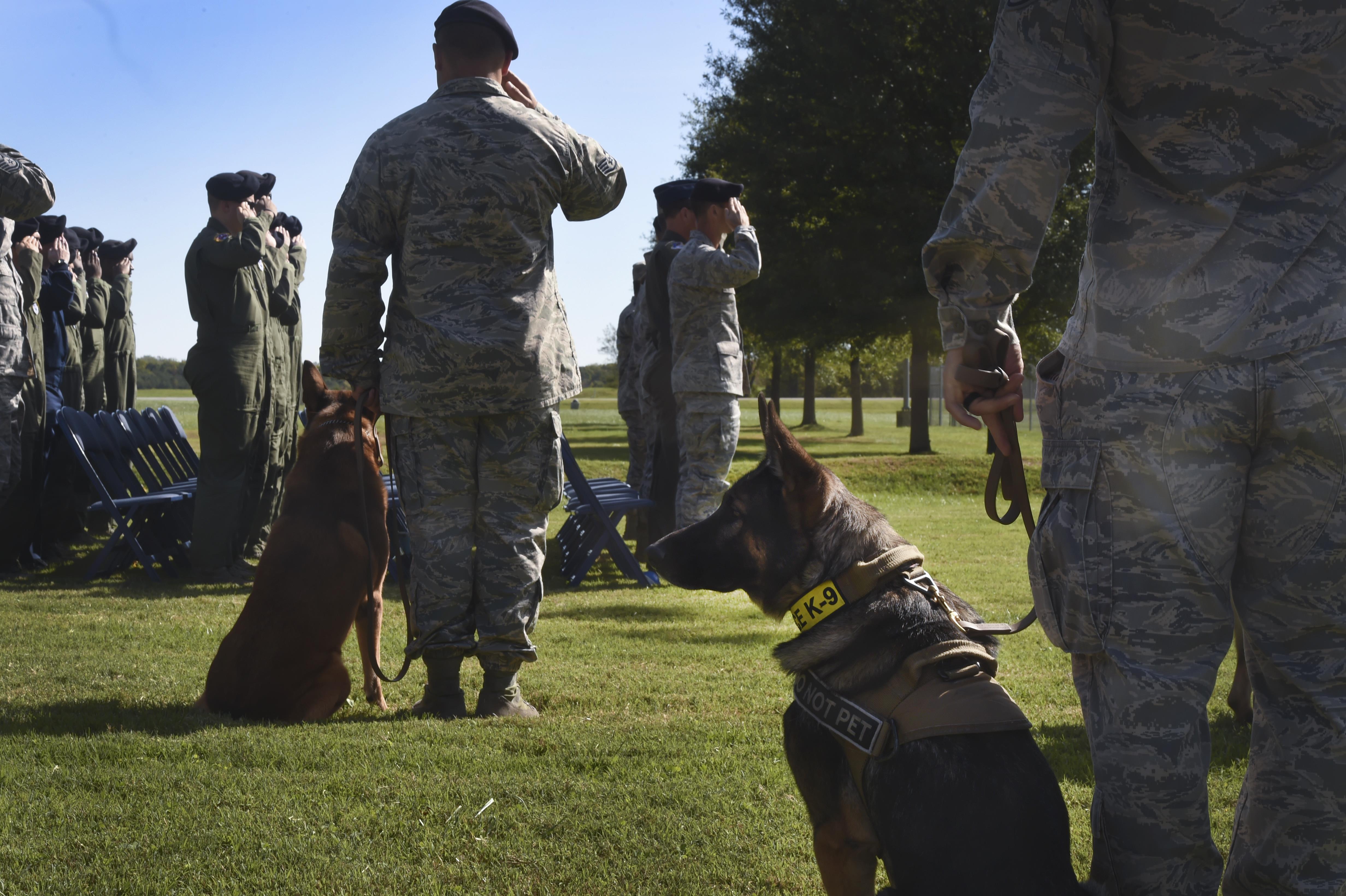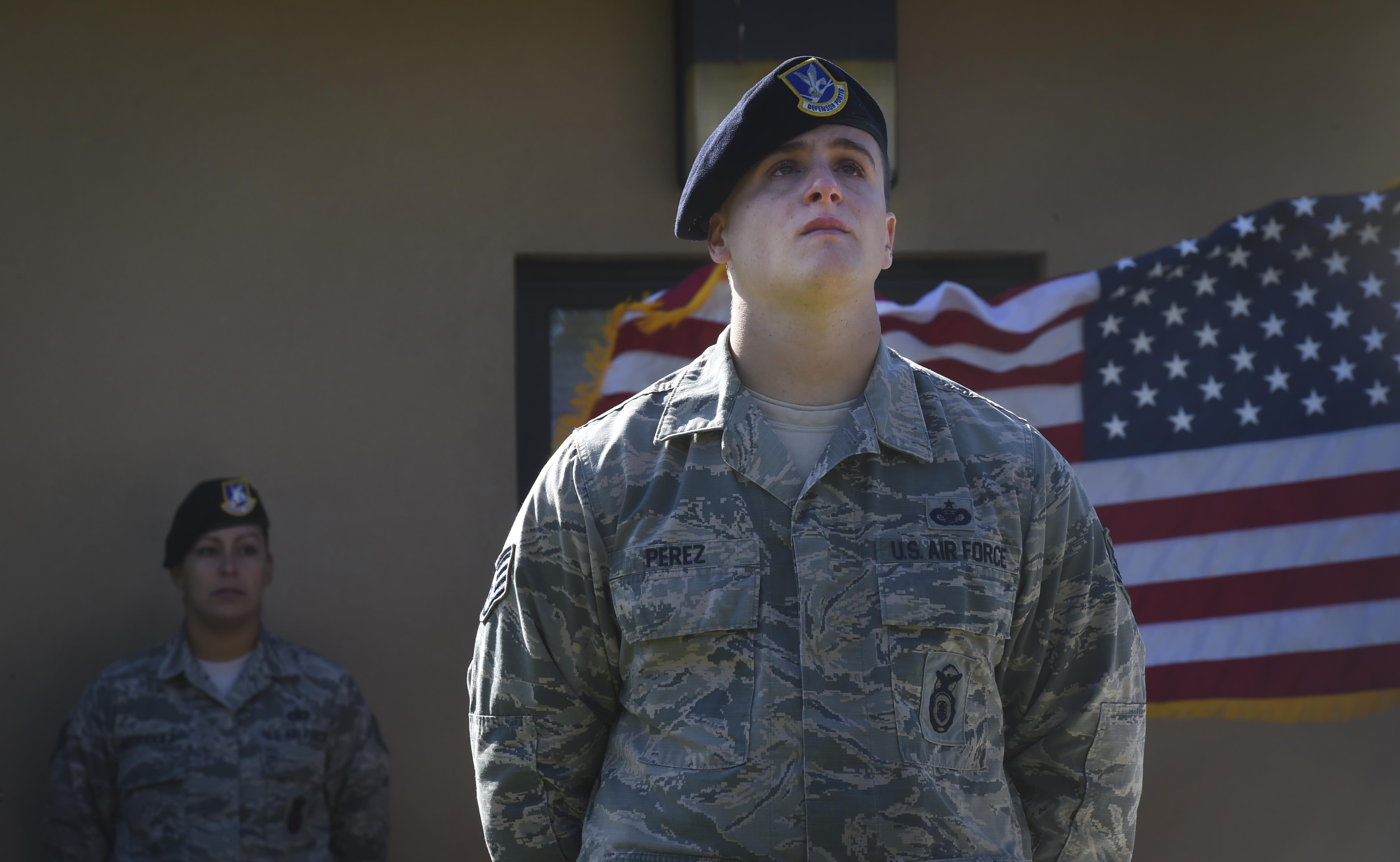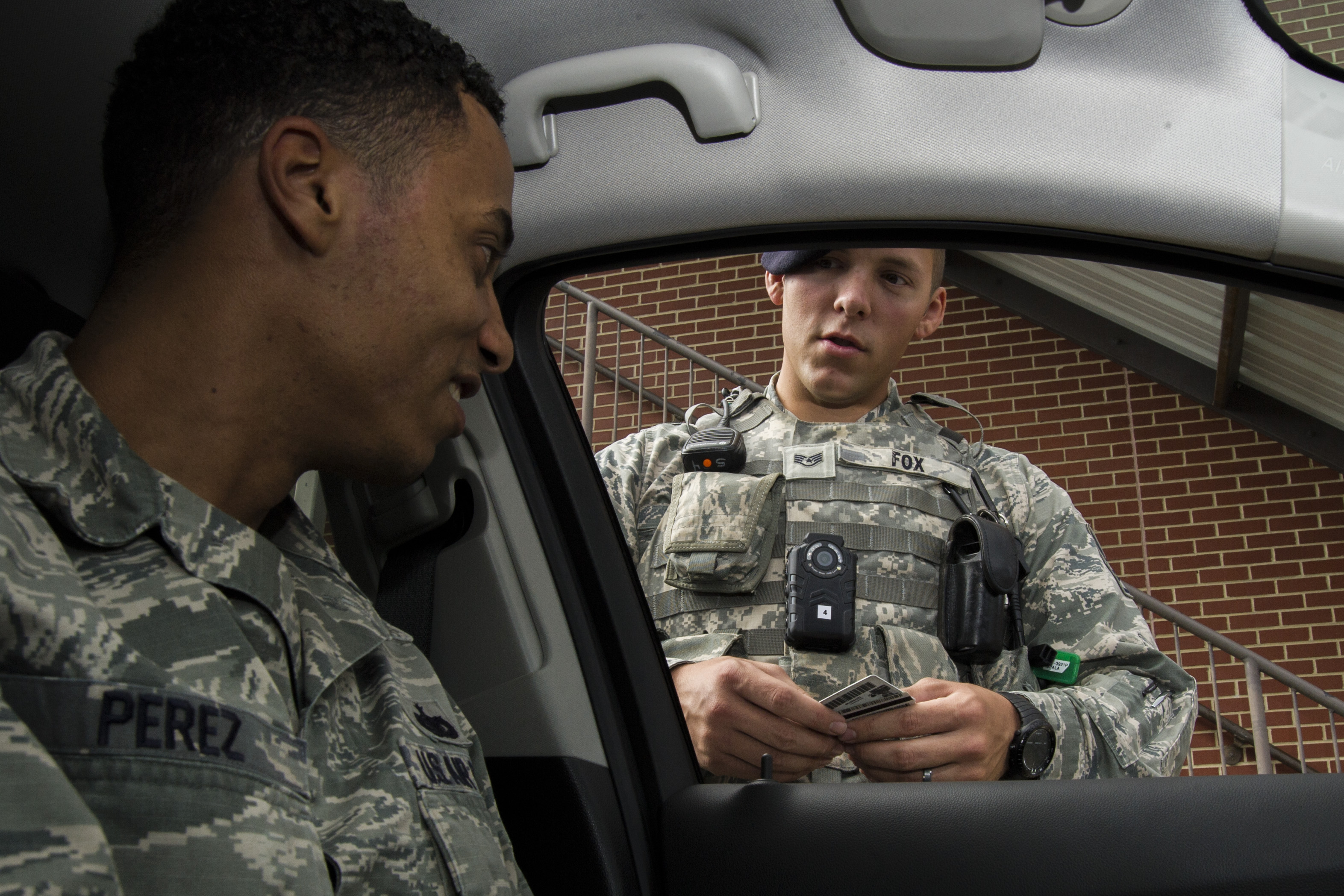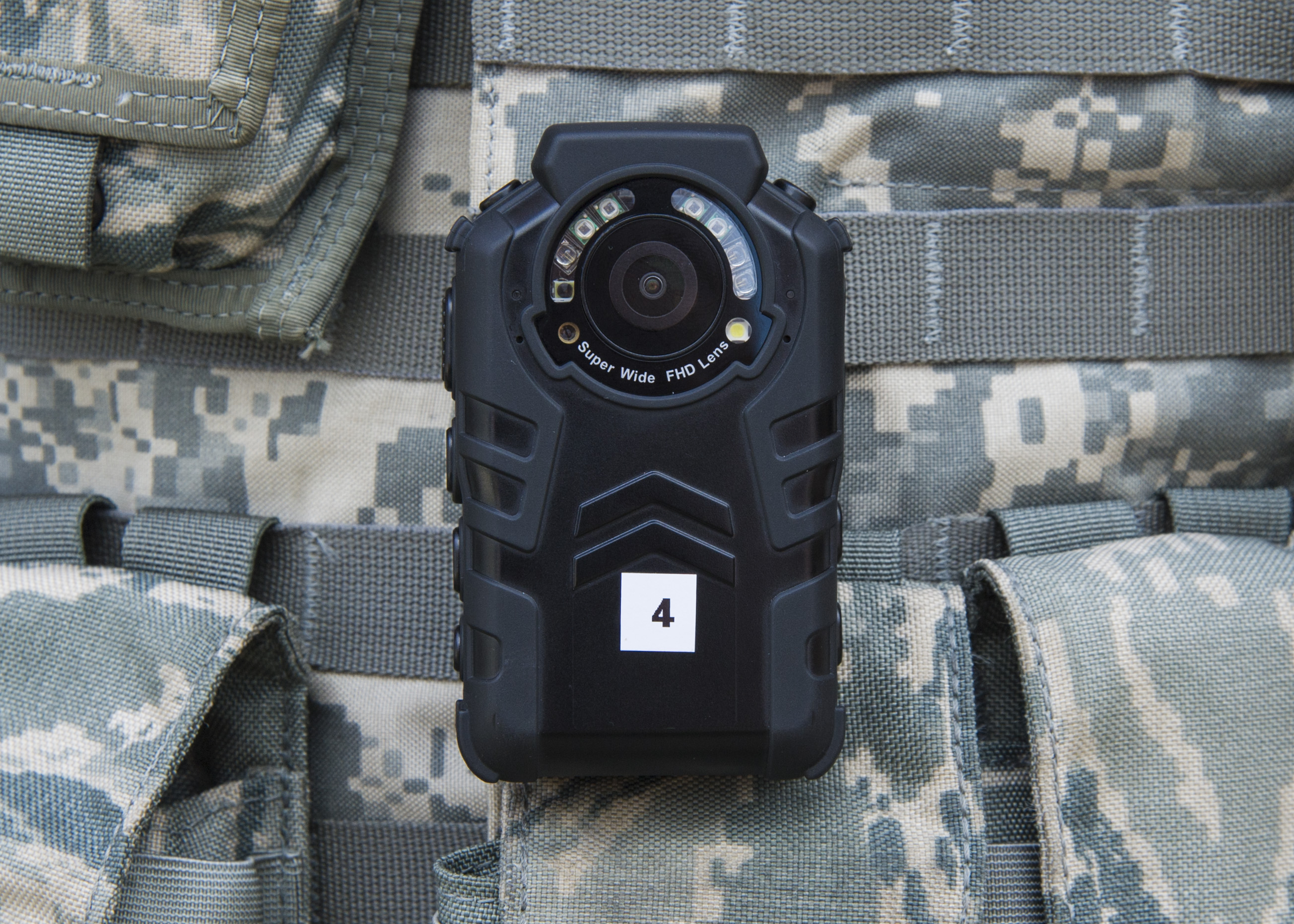569th USFPS, Local Police Receive International Award
By Senior Airman Jonathan Bass, 86th Airlift Wing Public Affairs / Published November 01, 2016
RAMSTEIN AIR BASE, Germany -- The 569th United States Forces Police Squadron joined local police in receiving an award for cooperation—the first time such an award had been given to an international partnership.
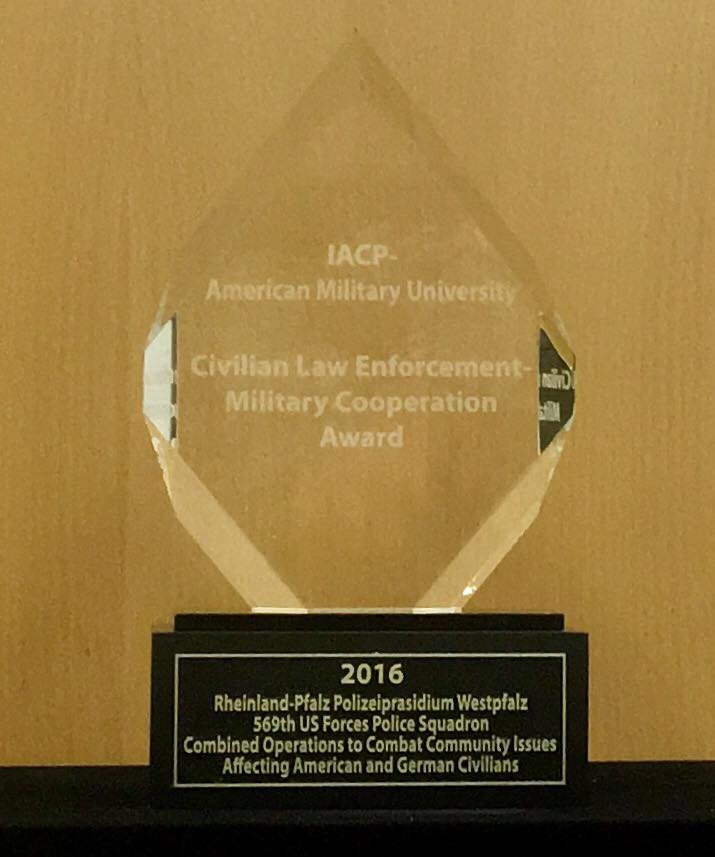
The International Association of Chiefs of Police (IACP) –awarded their 2016 Civilian Law Enforcement – Military Cooperation Award to the 569th USFPS and the Polizeiprasidium Westpfalz in Kaiserslautern, Germany.
Representatives from both units were on hand at the IACP conference in San Diego, California, Oct. 16, 2016.
“This award recognizes excellence in law enforcement cooperation between civilian and military law enforcement agencies in developing innovative joint efforts that lead to improvement in public safety for both military and civilian communities,” said Capt. John-Paul Adrian, 569th USFPS operations officer. “It is bestowed on two partner law enforcement organizations, one military; one civilian, each year by a subcommittee of the IACP. The goal of the committee is to foster a closer relationship between the civilian and military law enforcement disciplines so that each can take mutual advantage of the other's skills, knowledge, training, research and development, and equipment in the law enforcement field for the benefit of those being served.”
The relationship between local national police and Air Force security forces play a crucial part to keeping U.S. service members and civilians safe.
“This award comes from a prestigious association of international police leaders and means a great deal to the law enforcement officers of both the 569th USFPS and Polizeipräsidium Westpfalz,” said Adrian. “It recognizes the fantastic relationship between the Status of Forces Agreement and host nation populations in the Kaiserslautern Military Community and how we team up every day as part of our combined community. This is also the first time that this award has been bestowed upon an international partnership, so this makes both departments all the more proud to receive this accolade.”
At a press conference, Oct. 28, at Polizeiprasidium Westpfalz headquarters in Kaiserslautern, the two units presented the award to the public.
The 569th USFPS and Polizeipräsidum Westpfalz distinguished themselves through outstanding cooperation in support of law enforcement operations in the Kaiserslautern Military Community. During this time, the two agencies crossed the divide between military and civilian law enforcement agencies in order to provide a safer joint community, comprised of 335,000 German and American citizens, according to the citation accompanying the award.
“Both agencies have incredible police officers and professionals,” said Adrian. “Based on these relationships, we are able to better learn from one another, as well as operate a combined and truly cohesive team – especially while responding to help members in our community, alongside one another.”
The partnership between the two units ensures the safety and security of the KMC by patrolling the downtown bar district, canvasing neighborhoods during a spree of serial burglaries and engaging in emergency services during a manning shortfalls.
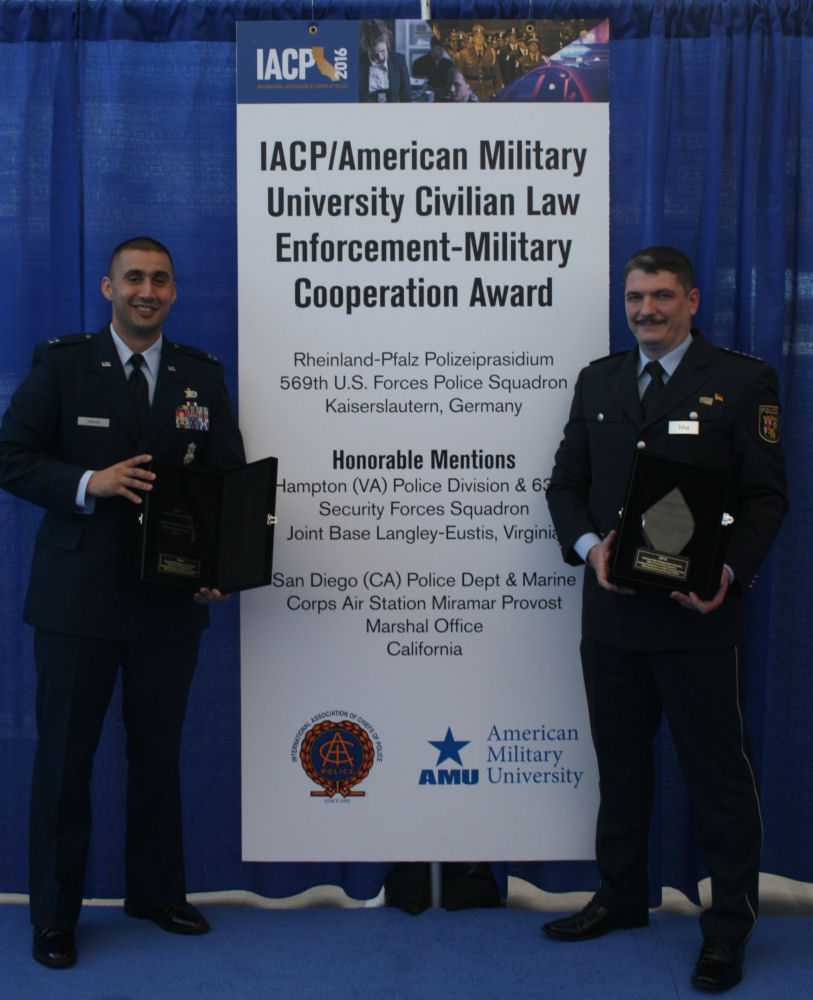
U.S. Air Force Capt. John-Paul Adrian, 569th United States Forces Police Squadron operations officer, and Polizeihauptkommissar Simon Mai, accepted the International Association of Chiefs of Police Civilian Law Enforcement– Military Cooperation award in San Diego, California, Oct. 16, 2016. The members of the 569th USFPS and Polizeipräsidum Westpfalz distinguished themselves through outstanding cooperation in support of law enforcement operations in the Kaiserslautern Military Community, Kreis Kaiserslautern, Federal Republic of Germany, from June 1, 2015 to June 1, 2016. During this time, the two agencies crossed the divide between military and civilian law enforcement agencies in order to provide a safer joint community comprised of 335 000 German and American citizens.

Chief White held his retirement ceremony the last weekend of October in his home state of Kentucky concluding a stellar 30 years of service to the Air Force and Security Forces. BGen (ret) Jamerson presided over the ceremony. Best wishes from all of AFSFA Chief … thanks for your leadership and friendship. Well done Defender!
Grissom Museum Opens New Air Force Police Exhibit
Former Grissom Officer Garners Donations From Retired Security Police
Kokomo Tribune, Carson Gerber, Oct 31, 2016
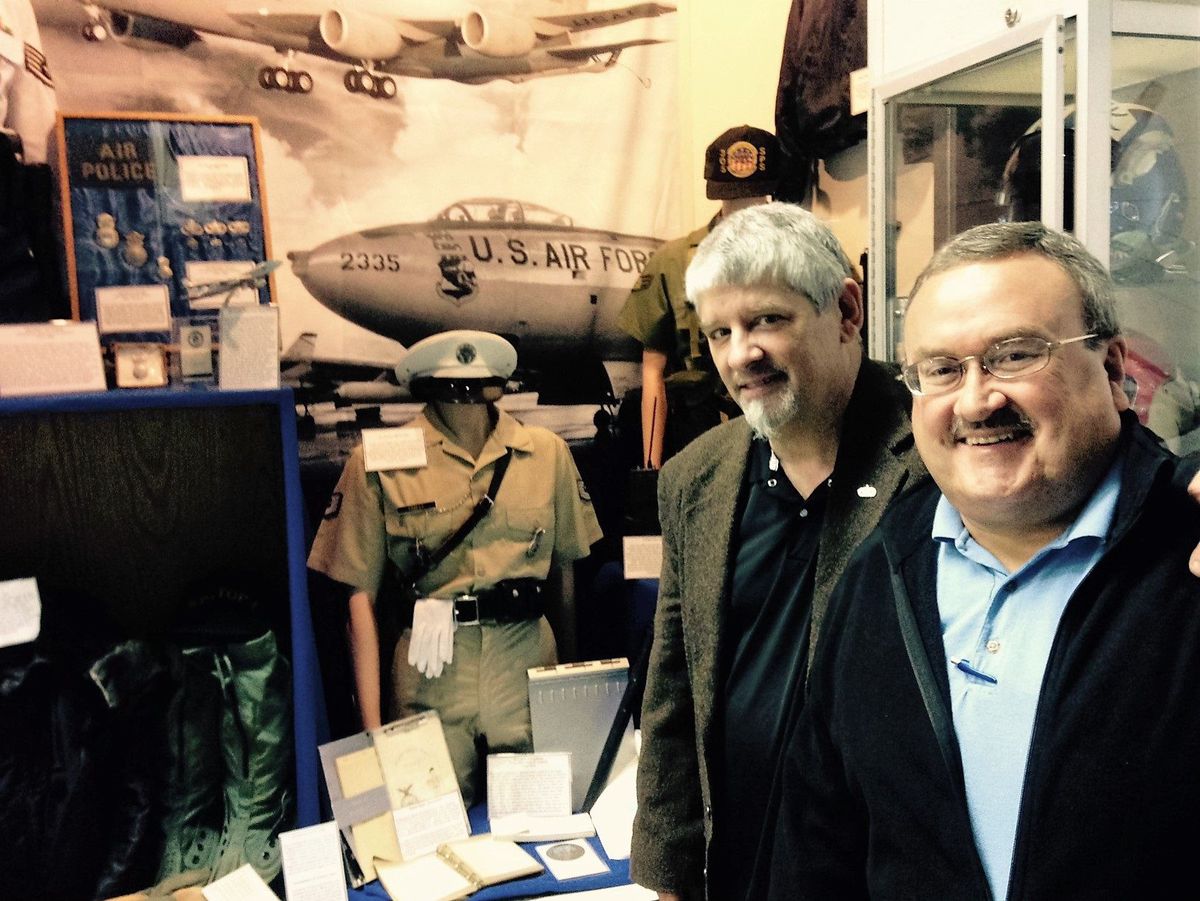
Retired MSgt Chris Armold, left, and Grissom Air Museum Director Jim Price stand near a new exhibit at the museum dedicated to the Air Force security police. Armold donated all the artifacts included in the exhibit. Submitted photo.
BUNKER HILL – One of the most extensive exhibits in the country dedicated to Air Force security police has opened inside the Grissom Air Museum thanks to donations from a former airman who served at the base.
Retired Master Sgt. Chris Armold recently donated the complete exhibit, which features the history, uniforms and weaponry of the airmen who protected the combat aircraft and personnel assigned to Bunker Hill and Grissom Air Force Base throughout the Cold War.
The Air Force first developed the concept of infantry-style units to defend air bases in the 1940s. They eventually developed into ground defense units protecting the military’s nuclear weapons systems.
Armold said he was assigned to the security police force at Grissom in 1983, and retired as an Air Force security policeman. He also served as the vice president of the Heritage Museum Foundation, the forerunner of the Grissom Air Museum.
He said he came up with the idea to create a museum exhibit dedicated to Air Force security police after attending a reunion this summer for veterans of Grissom’s 305th Security Police.
“For me, the opportunity to create an air police and security police exhibit for a museum I was a part of 30-plus years ago was just too good to be true,” Armold said in a release.
Over the next few months, he garnered a horde of artifacts and items donated by former Air Force security officers from across the country, such as uniforms, equipment, patches and documents. The exhibit also includes replicas of the weapons used by security officers.
Tom Kelley, a museum volunteer and former security officer at Grissom who helped organize the exhibit, said the new display is part of the museum’s mission to remember every airman who served at the base.
“That whole museum is there to celebrate the legacy of the people who served on the base, as well as their mission,” he said. “We want everybody to understand what the base was all about and celebrate its history, and the security police are a very important part of that whole operation.”
Kelley said the security police exhibit is one of the most extensive collections outside the Airman Heritage Museum in San Antonio, Texas, and offers unique insights into the history of the Air Force’s security forces that can’t be found anywhere else in the area.
“We’re really excited about having this,” he said.
For Armold, who is an historian and author who has written a new book about Air Force police, the exhibit is a way to commemorate and honor the airman who served as security officers, just like he did at Grissom.
“I hope people who visit this exceptional museum will enjoy the display,” he said. “I'm proud to have served at Grissom Air Force Base and always enjoy returning to the area. It still feels like home to me.”
The Grissom Air Museum is now operating in off-season hours and is open 10 a.m. to 4 p.m. Friday through Sunday. Admission will be free to prior military personnel during the Veterans Day weekend.
All Military Dogs Go to Heaven
By Senior Airman Mariah Haddenham, 11th Wing Public Affairs, October 28, 2016
Military working dogs wait in formation during a memorial service for two dogs who recently passed away at Joint Base Andrews, Md., Oct. 28, 2016. The service honored the MWD’s accomplishments and included a 21 gun salute and the playing of Taps. (U.S. Air Force photo by Senior Airman Mariah Haddenham)
Service members salute during a memorial service Oct. 28, 2016, at Joint Base Andrews, Md., for two military working dogs who recently passed away. The service honored the MWD’s accomplishments and included a 21-gun salute and the playing of Taps. (U.S. Air Force photo by Senior Airman Mariah Haddenham) (Photo by Senior Airman Mariah Haddenham)
Staff Sgt. Yessiell Perez, 11th Security Forces Squadron military working dog handler, stands at parade rest during a memorial service at Joint Base Andrews, Md., Oct. 28, 2016. The service honored the MWD’s accomplishments and included a 21-gun salute and the playing of Taps. (U.S. Air Force photo by Senior Airman Mariah Haddenham) (Photo by Senior Airman Mariah Haddenham)
JOINT BASE ANDREWS, MD --
The atmosphere was visibly solemn as defenders from the 11th Security Forces Group stood at attention on Joint Base Andrews, Maryland, Oct. 28, to pay their respects to two decorated American heroes.
An Afghanistan veteran, and the other a vital part of JBA security, both left ‘pawsitive’ impressions on their coworkers.
“Military working dogs are a vital asset to Air Force operations and are considered essential for detection of explosives and narcotics due to their sense of smell being 20 times more powerful than a human’s,” said Staff Sgt. Derek Scrivener, 11th Security Support Squadron military working dog handler. “The dogs are highly skilled and can be used as attack dogs when necessary.”
MWD Riso was born Oct. 23, 2006, and began his career in the Air Force Dec. 7, 2007. Riso was certified for narcotics detection before starting his career at JBA. Riso worked with nine handlers over a span of 10 years, providing security and multiple positive narcotics detections, and was deployed to Afghanistan in 2011 and 2012. MWD Riso passed away Oct. 3, 2016 due to medical conditions.
His wingman, MWD Kart, was born Nov. 7, 2007 and was accepted into the Air Force in January of 2008. Kart was certified for explosive detection before starting his career at JBA, where he worked with seven handlers in seven years. MWD Kart provided security for copious amounts of high-profile events and distinguished leaders and visitors from around the world. Kart was retired from duty June 13, 2016, and was adopted by Tech Sgt. Jake Twaddle, where he enjoyed civilian life until he had to be put down Oct. 6, 2016, due to medical complications.
“It didn’t matter what we were doing, whether it was driving around base seeing the vet for a checkup or spending hours inspecting car after car at the search pit,” said Tech Sgt. Codi Carter, Pentagon military security force team leader. “No matter what, he was always happy.”
The Military Working Dog Adoption program, enacted by Congress in 2000, allowed adoption of retiring dogs to law enforcement agencies, former handlers and other persons capable of caring for the dogs. This program gives the dogs an opportunity to live life as a normal dog, and allowed Kart to live his last days to the fullest.
“Our MWD’s are truly one of a kind,” said Tech. Sgt. William Stone, 11th SSPTS MWD section kennel master. “From seeking our intruders, enforcing zero drug tolerance to protecting people and resources from explosives, these MWD’s faced the most difficult tasks with no fear. All they want is to keep their handler safe and make them happy and we are truly thankful for all they do.”
JBA Holds Body Camera Test for SFS Evidence
By 11th Wing Public Affairs, JOINT BASE ANDREWS, MD, October 26, 2016, Senior Airman Jordyn Fetter
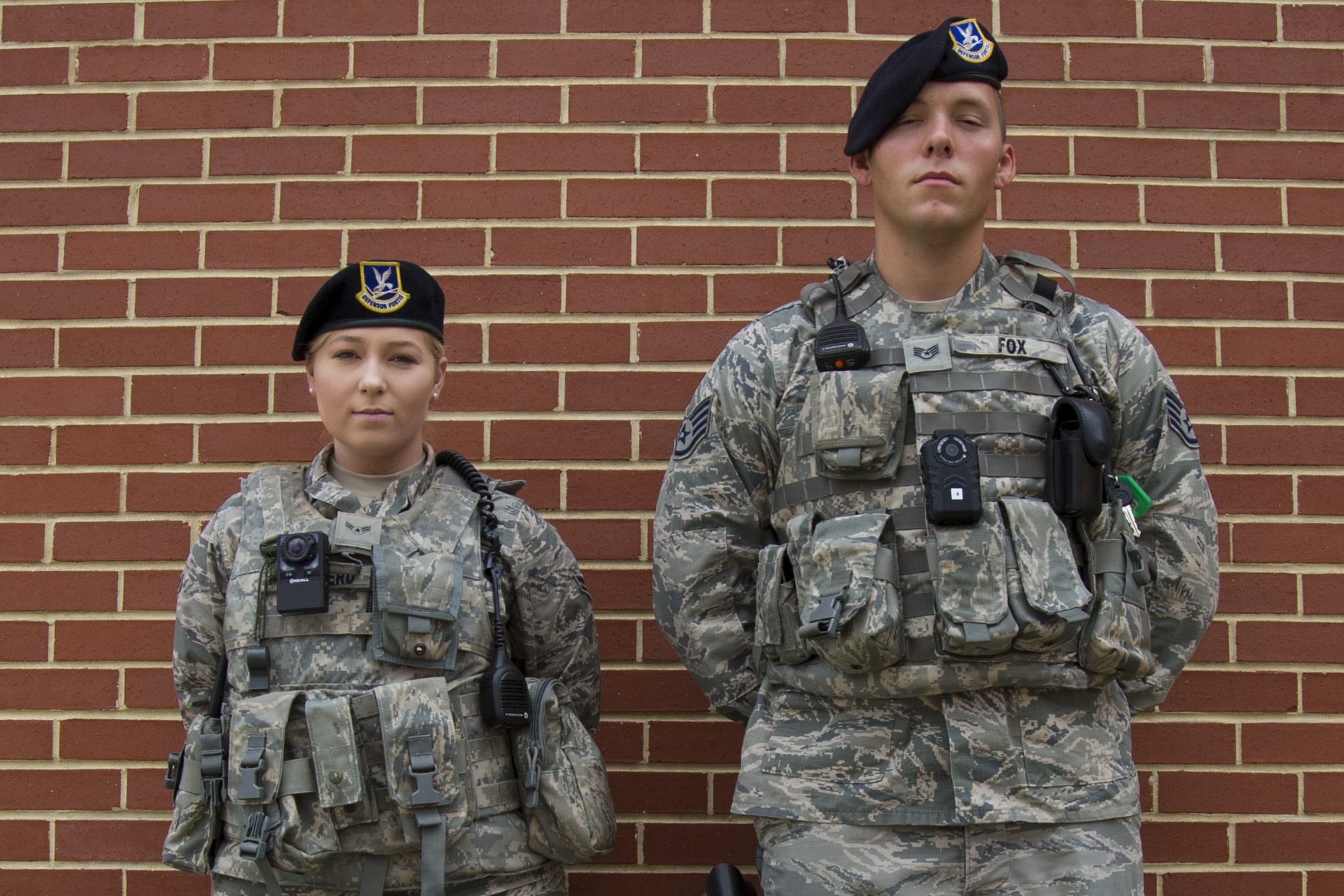
Airman 1st Class Sarah Shepherd, left, and Staff Sgt. Sawyer Fox, right, 11th Security Forces Squadron response force leaders, display the wear of body cameras at Joint Base Andrews, Md., Oct. 4, 2016. JBA defenders began donning the body worn cameras Oct. 26 as part of a six-month-long Air Force-level test to determine which product to use. The cameras will be evaluated on their video quality, usefulness, and how they can be better utilized. (U.S. Air Force photo by Senior Airman Jordyn Fetter)
Staff Sgt. Sawyer Fox, 11th Security Forces Squadron response force leader, checks an identification card while wearing a body camera at Joint Base Andrews, Md., Oct. 4, 2016. The cameras are in the process of undergoing an Air Force-level test, which began Oct. 26, to determine their recording quality, usefulness, and how they can be better utilized. Throughout the test plan, approximately nine cameras will be worn at a time by law enforcement officers, lead gate guards, K-9 handlers, the emergency services team, and training and quality care officers. (U.S. Air Force photo by Senior Airman Jordyn Fetter) (Photo by Senior Airman Jordyn Fetter)
A single body worn camera rests on an 11th Security Forces Squadron officer’s flak vest at Joint Base Andrews, Md., Oct. 4, 2016. These devices were implemented Oct. 26 as part of an Air Force-level test to determine which kind of camera will best suit the service’s defenders and their procedures. (U.S. Air Force photo by Senior Airman Jordyn Fetter) (Photo by Senior Airman Jordyn Fetter)
Staff Sgt. Sawyer Fox, right, and Airman 1st Class Sarah Shepherd, left, 11th Security Forces Squadron response force leaders, record information in a notebook during a patrol at Joint Base Andrews, Md., Oct. 4, 2016. JBA security forces defenders will be wearing the products for a period of six months as part of a test to determine which kind of camera to use throughout the Air Force. One of the main goals during the process is to disperse the new equipment information throughout the community to ensure they feel safe and aware. (U.S. Air Force photo by Senior Airman Jordyn Fetter) (Photo by Senior Airman Jordyn Fetter)
Members of the 11th Security Forces Squadron began using body worn cameras here Oct. 26, 2016 to further develop Air Force security forces evidence-collecting capabilities.
The implementation of the devices is part of a Headquarters Air Force dictated test plan to determine which kind of camera will best suit the service’s defenders and their processes.
“We’re looking to gain evidence,” said Staff Sgt. Samarre Perez, 11th SFS confinement NCO. “Cameras serve as secondary eyesight and footage can bring light to a situation.”
The test period will last for approximately six months here, during which, two different types of cameras will be put through rigorous training to determine their recording quality, usefulness, and how they can be better utilized.
“Test plans are common for equipment,” Perez said. “We test products to determine their pros and cons and if it’s successful, a larger plan will be made to make the purchase. It’s a less expensive solution than spending millions of dollars on a product only to find out it wasn’t necessary in the first place.”
Security forces members received training from product vendors in preparation for the wear of the equipment.
“We participated in something called ‘train the trainer’,” Perez said. “It’s when the vendor brings their own private team to train you on their camera software and equipment for a day.”
Following the initial training, the team taught military personnel how to tailor the equipment to their unit’s procedures and educate the remaining security forces members on their use.
“We learned the camera’s capabilities, specifications, and what it can and can’t handle,” said Perez. “Then, we geared up to train the rest of security forces during the second phase.”
To ensure an encompassing test of quality, approximately nine cameras will be worn at a time by law enforcement officers, lead gate guards, K-9 handlers, the emergency services team, and training and quality care officers, Perez said.
While the wear of the body cameras will not have a significant impact on the way defenders conduct their mission, a few minor changes may occur.
“We’re mostly just including the extra step of turning on the cameras before doing our law enforcement duty on-scene,” Perez said. “However, we’ve been looking into prefacing public interactions with a statement to ensure individuals know they are being recorded by cameras.”
Security forces’ goal is to disperse the new equipment information to the community as much as possible, so the public feels safe and more aware, Perez emphasized.
“It’s beneficial to have these body worn cameras because it promotes officer and community safety,” said Staff Sgt. Benjamin Castro, 11th SFS law enforcement administration NCO. “For example, if a subject is on the run and the cameras were involved during an altercation with the individual, you’ll be able to get positive identification on that subject and more easily find them.”
In addition to evidence collecting, the body cameras will be able to assist officers in training as well as provide a firsthand look at altercations in court.
“A situation can go from a simple noise complaint to a full-blown domestic assault when arriving on-scene,” said Perez. “DUIs are especially important. Someone can deny taking an intoxication test, but the footage would fully represent how unfit they were to drive.”
Ultimately, the cameras will assist with filling in the gaps in altercations when they need to be recounted for evidentiary purposes.
“In the law enforcement realm, situations can go from 0 to 100 really fast,” Perez said. “The cameras provide a ‘bird’s eye view,’ that gives us a second chance to see a scene and experience it as it happens. Recounting it for a report with only your memory as a guide is difficult, but cameras tell the totality of the story and put everything into perspective.”
Page 42 of 50

